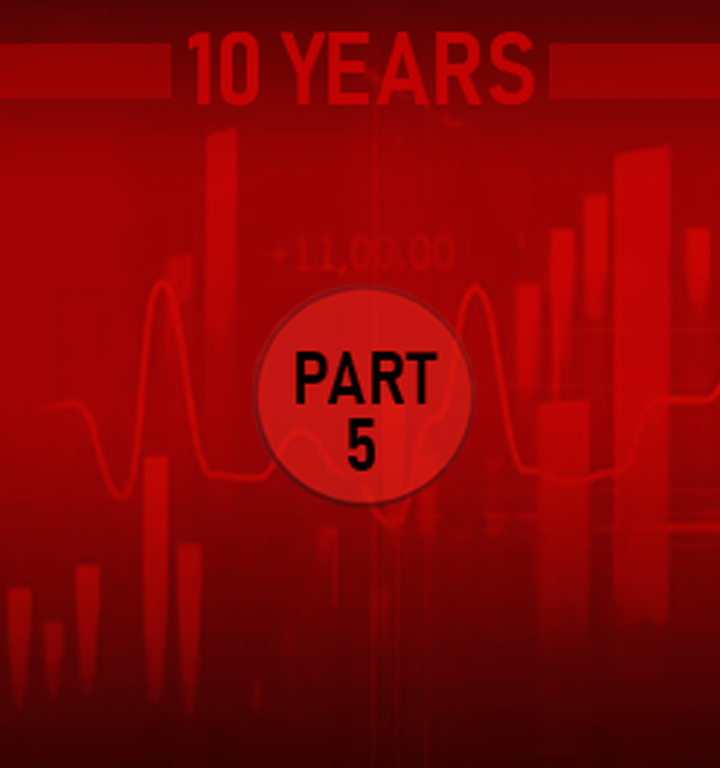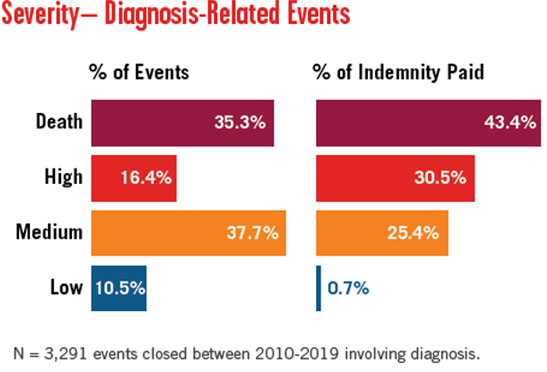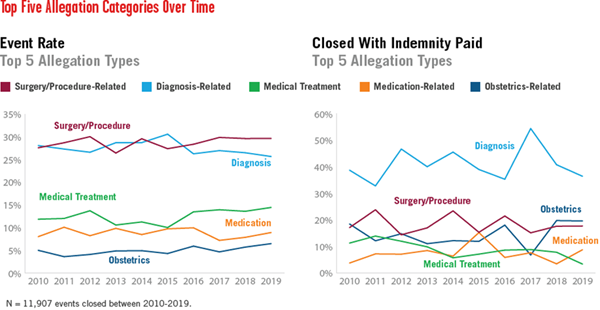
View Expert Insights
April • 6 • 2021
Insights From 10 Years of Malpractice Claims Data: Part III
Article
Summary
Coverys’ special report, A Call for Action: Insights From a Decade of Malpractice Claims, examines data derived from 11,000+ events pertaining to 20,000+ closed claims across a 10-year period (2010 to 2019). This is the third of a five-part blog series based upon the report.
Top Claim Trends
There is always the potential for risk when delivering or receiving medical care. Often these risks remain largely invisible until a patient experiences a poor outcome. Efforts to learn from missteps through peer review, incident reporting, and patient safety organization work have been ongoing for more than 20 years, with the goal of proactively reducing risk. Yet, when the root causes of these problems either are not well understood or not appropriately prioritized, many of the issues we see in malpractice-related events cannot be dealt with in an impactful way.We see slight modifications in the claims data and improvements in diagnosis that are promising. However, given the outcomes stemming from missed and delayed diagnosis scenarios and the resultant higher-than-average payouts, there is more to be done.
This article provides a breakdown of the most frequent types of allegations reported and some detail on the top two allegations: surgery/procedure-related and diagnosis. Additional detail and risk recommendations for top allegation types are provided in the report.
Top Allegations
Surgery/procedure-related allegations are the most frequent in our data, followed closely by diagnosis-related allegations.Diagnosis-related allegations are the costliest. Surgery/procedure- and diagnosis-related allegations combined account for 57% of allegations and 59% of indemnity paid. It follows that if focused attention is paid to significant—and sustained— improvement in those two categories alone, it could have a major positive impact on improved patient safety and could result in fewer malpractice claims.


Data derived from 11,907 events pertaining to 20,211 closed claims at Coverys across a 10-year period from 2010 to 2019. Coverys. (2020). A call for action: Insights from a decade of malpractice claims. https://www.coverys.com/PDFs/call-for-action-decade-of-malpractice-claims.aspx
Top Five Allegation Categories Over Time


Data derived from 11,907 events pertaining to 20,211 closed claims at Coverys across a 10-year period from 2010 to 2019. Coverys. (2020). A call for action: Insights from a decade of malpractice claims. https://www.coverys.com/PDFs/call-for-action-decade-of-malpractice-claims.aspx
Surgery/Procedure-Related Events
Surgical care is inherently risky and, when things go wrong, is a common basis for malpractice claims. Despite widely distributed guidance, checklists, team training, and simulation aimed at reducing their prevalence, events continue to occur involving retained foreign bodies, wrong-site procedures, and less-than-optimal team performance. Fatigue, hierarchy, and distractions still affect experienced surgeons’ decision-making, technical ability, and team leadership skills. Surgery events have the second-highest total indemnity (18%). Average gross paid indemnity for surgery/procedure-related events was $374,449.
Surgery/procedure-related events are the most common allegation category. Surgery performance issues accounted for 78% of events and 72% of indemnity paid. Performance-related issues, specifically technical skill, predominate in these events.


Data derived from 11,907 events pertaining to 20,211 closed claims at Coverys across a 10-year period from 2010 to 2019. Coverys. (2020). A call for action: Insights from a decade of malpractice claims. https://www.coverys.com/PDFs/call-for-action-decade-of-malpractice-claims.aspx
As expected, most indemnity payments result from events that occur in the operating rooms of hospitals and outpatient facilities. We see 66% of events occur in surgery and 17% in the physician office, before dropping to 3% in clinics and emergency departments, and finally, 2% in the patient’s hospital room.


Data derived from 11,907 events pertaining to 20,211 closed claims at Coverys across a 10-year period from 2010 to 2019. Coverys. (2020). A call for action: Insights from a decade of malpractice claims. https://www.coverys.com/PDFs/call-for-action-decade-of-malpractice-claims.aspx
Diagnosis-Related Events
Diagnostic error is a primary contributor to healthcare-related patient harm. Arriving at an accurate diagnosis is a process that can be derailed by bias, time pressure, and knowledge gaps—even for experienced diagnosticians. To help improve diagnostic safety, clinicians and organizations can learn from data to enhance the daily practice of care to ensure diagnoses are correct and acted upon without unnecessary delay.
Three allegations, involving history & physical/evaluation of patient, interpretation of tests, and ordering diagnostic/lab tests, comprise 79% of events and 75% of indemnity payments, with allegations involving interpretation of tests being the costliest. In 2016, the number of diagnosis allegations dropped and remained below surgery allegations over the following four years. Diagnosis-related events have continued to trend slightly downward over the last five years but that movement is not statistically notable. The 10-year average indemnity payment for diagnostic-related events was $600,000, second only to obstetrical events.


Data derived from 11,907 events pertaining to 20,211 closed claims at Coverys across a 10-year period from 2010 to 2019. Coverys. (2020). A call for action: Insights from a decade of malpractice claims. https://www.coverys.com/PDFs/call-for-action-decade-of-malpractice-claims.aspx
Death and high-severity injury constitute 52% of events and 74% of indemnity paid. High-severity injury and death allegations are mostly attributable to missed or delayed cancer diagnoses.


Data derived from 11,907 events pertaining to 20,211 closed claims at Coverys across a 10-year period from 2010 to 2019. Coverys. (2020). A call for action: Insights from a decade of malpractice claims. https://www.coverys.com/PDFs/call-for-action-decade-of-malpractice-claims.aspx
For more information about medical treatment, medication, obstetrics-related severity levels, allegations, risk management issues, and case studies, please refer to pages 11-24 within A Call for Action: Insights From a Decade of Malpractice Claims.
Copyrighted. No legal or medical advice intended. This post includes general risk management guidelines. Such materials are for informational purposes only and may not reflect the most current legal or medical developments. These informational materials are not intended, and must not be taken, as legal or medical advice on any particular set of facts or circumstances.